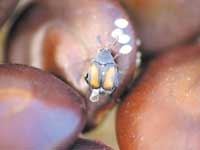|
UK Research Focuses On Insect’s Response To Changing Environmental Conditions
LEXINGTON, KY.
Seed beetles, native to the Southwest, can change the size of their eggs to increase their offspring’s survival rate. A post-doctoral scholar in the University of Kentucky College of Agriculture, Food and Environment is studying how the beetle does this, with the goal of using it as a model to understand how insects, including other seed beetles that are major agricultural pests in Asia and Africa, respond to changing environmental conditions.
“Mothers can sense changes in the environment and make particular physiological or behavioral changes to their offspring, so when they are born they can better handle their environment,” said Joe Deas, a researcher in the laboratory of UK entomologist Charles Fox. “They can sense any type of environmental factor … the level of competition, the amount of resources, the presence of predators, temperature and humidity. While reports of these transgenerational effects are common, there are few examples of how this works at the molecular level.”
Deas, a UK Lyman T. Johnson Postdoctoral Fellow, is studying the egg-laying habits of the seed beetle Stator limbatus. The females lay eggs on the seeds of the catclaw acacia and the blue palo verde, both native trees to the Southwest. Once the eggs hatch, the larvae burrow into the seed and use the seed to grow. About a month later, they emerge from the seed as adults.
“The beetles do really well on catclaw acacia. It’s a really nutritious host for them, but they don’t do well on blue palo verde at all,” he said. “Blue palo verde is a lower quality host. Blue palo verde actually has a toxic seed coat that the larvae have to burrow through first. The larvae actually die before they are able to penetrate into the seed.”

Stator limbatus on a seed.
PHOTO: Tuan Cao, University of North Carolina at Charlotte
As a result, the female seed beetle lays smaller eggs on the catclaw acacia seeds and larger eggs on the blue palo verde seeds.
“When the female increases her eggs’ size it actually results in more offspring surviving on the blue palo verde, but no one knows why that is,” he said.
Fox has conducted similar research on the same seed beetle and has determined that egg size plays a part in the story, but it’s not the whole story. Deas believes the mother seed beetle has the ability to alter the composition of her egg in some way.
In the next couple of years, Deas will attempt to identify the toxins or proteins that are in the palo verde seed coat. This should give him an idea of the type of detoxification mechanisms the beetles may possess. In addition, he hopes to identify the regulatory pathways that are initiated in the beetle, both when the mother modifies eggs and when the larvae break down the toxins. Deas hopes to expand this work to storage-pest seed beetles that can also modify egg size in response to environmental changes.
This is familiar territory for Deas. When earning his doctorate at the University of Arizona, Deas found that another seed beetle, Mimosestes amicus, protects its eggs from predatory parasitic wasps by laying between one and three eggs on top of another egg. Wasps attack the eggs on the top. The top eggs are poor hosts for the wasp larvae to survive in, while the egg on the bottom of the stack contains an unharmed beetle larva.∆
|
|